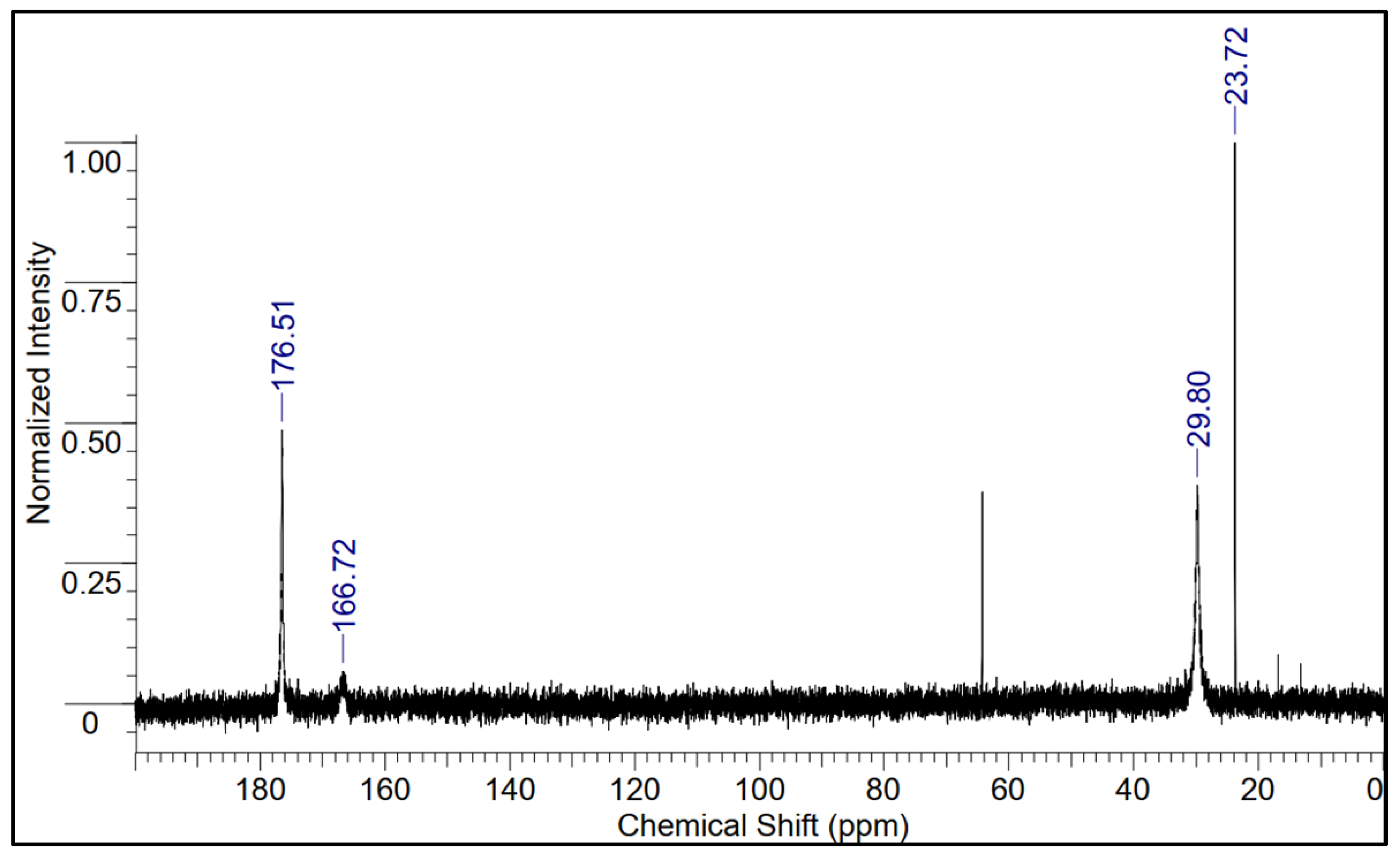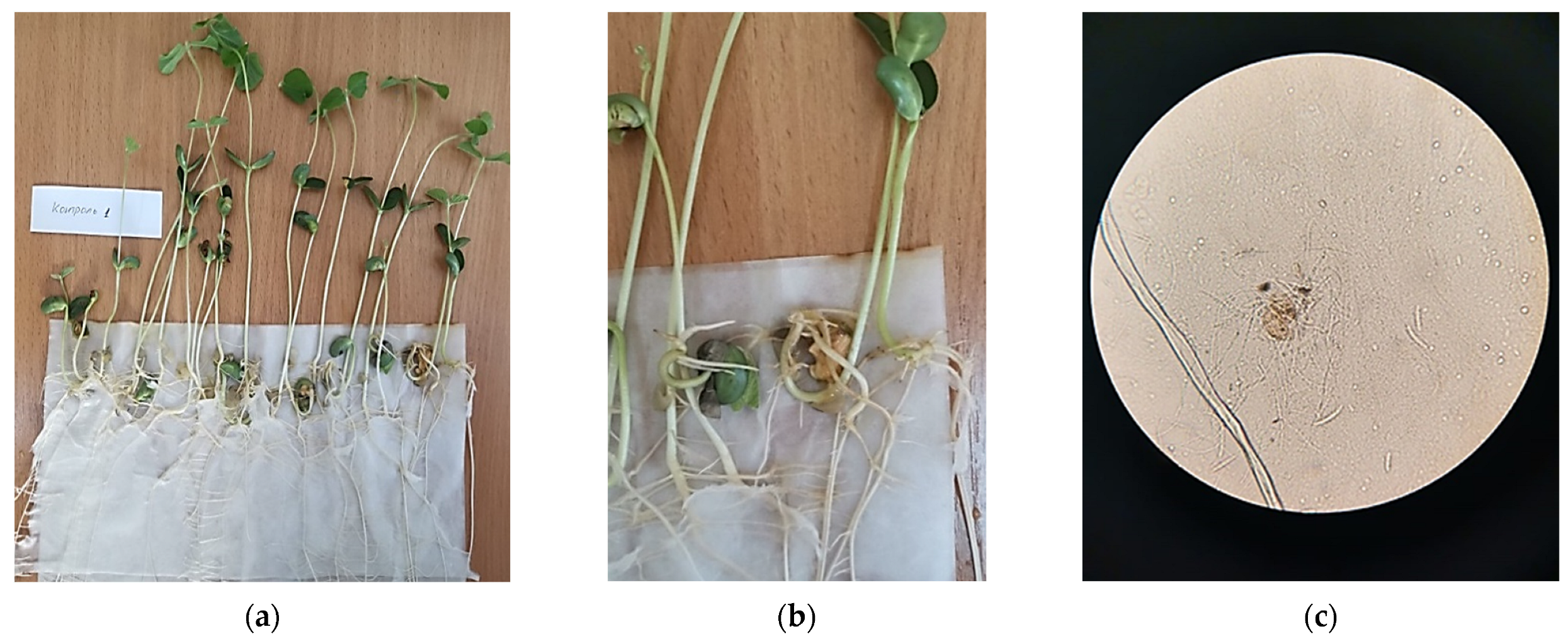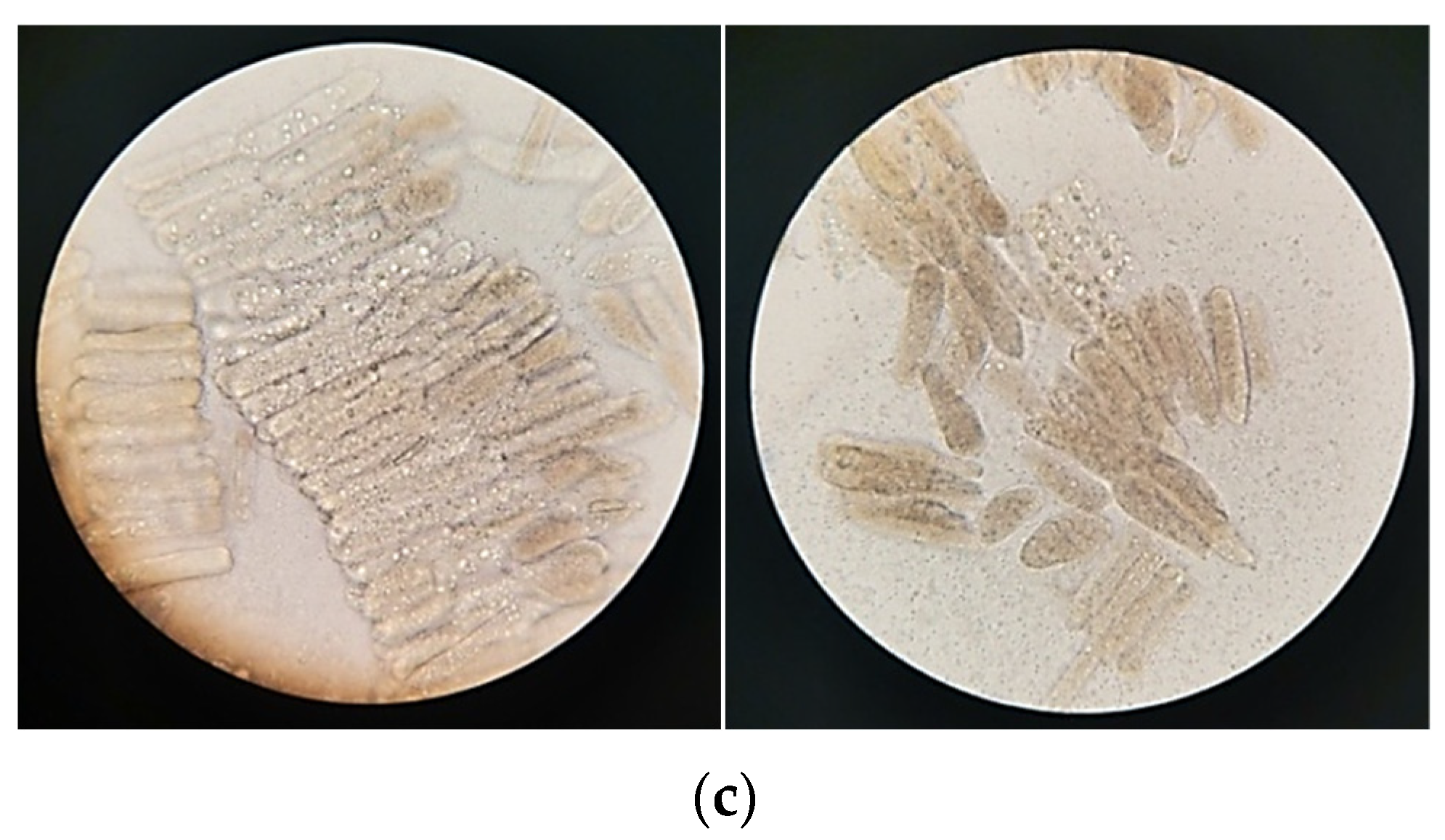Fungicidal and Stimulating Effects of Heteroleptic Copper Complex on the Germination and Phytosafety of Plants
Abstract
1. Introduction
2. Experimental Section
2.1. Materials
2.2. Synthesis of [Cu(succ)(gly)]n
2.3. FTIR Spectroscopy
2.4. UV Analysis
2.5. Powder X-ray Diffraction Studies
2.6. NMR Analysis
2.7. SEM Analysis
2.8. Determination of the Effectiveness of [Cu(succ)(gly)] in the Laboratory
3. Results and Discussion
3.1. FTIR Analysis
3.2. UV Analysis
3.3. XRD Analysis
3.4. NMR Analysis
3.5. SEM Analysis
3.6. The Effectiveness of [Cu(succ)(gly)] in Laboratory Conditions
4. Conclusions
Author Contributions
Funding
Data Availability Statement
Acknowledgments
Conflicts of Interest
References
- Rai, S.; Singh, P.K.; Mankotia, S.; Swain, J.; Satbhai, S.B. Iron homeostasis in plants and its crosstalk with copper, zinc, and manganese. Plant Stress 2021, 1, 100008. [Google Scholar] [CrossRef]
- Meharg, A. Marschner’s Mineral Nutrition of Higher Plants, 3rd ed.; Marschner, P., Ed.; Elsevier/Academic Press: Amsterdam, The Netherlands, 2011; p. 684. ISBN 978-0-12-384905-2. [Google Scholar] [CrossRef]
- Michał, Z.; Frymark, J.; Nowak, M.; Grajewski, J.; Stachowiak, K.; Kaczmarek, M.T.; Jastrząb, R. Influence of d-Electron Diva-lent Metal Ions in Complex Formation with L-Tartaric and L-Malic Acids. Molecules 2021, 26, 5290. [Google Scholar] [CrossRef]
- Lin, C.-J.; Wang, P.-Y.; Lin, Y.-L.; Chang, S.-T.; Hsu, C.-S.; Wu, S.-P.; Wu, C.-H. Nonpolar Side Chains Affect the Photochemical Redox Reactions of Copper(II)–Amino Acid Complexes in Aqueous Solutions. ACS Omega 2021, 6, 28194–28202. [Google Scholar] [CrossRef] [PubMed]
- Kondratenko, Y.; Zolotarev, A.A.; Ignatyev, I.; Ugolkov, V.; Kochina, T. Synthesis, crystal structure and properties of copper(II) complexes with triethanolamine and carboxylic acids (succinic, salicylic, cinnamic). Transit. Met. Chem. 2020, 45, 71–81. [Google Scholar] [CrossRef]
- Batool, S.S.; Gilani, S.R.; Zainab, S.S.; Tahir, M.N.; Harrison, W.T.A.; Haider, M.S.; Syed, Q.; Mazhar, S.; Shoaib, M. Synthesis, crystal structure, thermal studies and antimicrobial activity of a new chelate complex of copper(II) succinate with N,N,N′,N′-tetramethylethylenediamine. J. Coord. Chem. 2020, 73, 1778–1789. [Google Scholar] [CrossRef]
- Keneie, D.N.; Satyanarayana, A.; Shyamala, P. Chemical Speciation Study of Ternary Complexes of Cu (II) with Succinic Acid Dihydrazide and Some Amino Acids in Aqueous Solution. J. Chem. Mater. Res. 2015, 7, 93–102. [Google Scholar]
- Yusuf, T.L.; Oladipo, S.D.; Zamisa, S.; Kumalo, H.M.; Lawal, I.A.; Lawal, M.M.; Mabuba, N. Design of New Schiff-Base Copper(II) Complexes: Synthesis, Crystal Structures, DFT Study, and Binding Potency toward Cytochrome P450 3A4. ACS Omega 2021, 6, 13704–13718. [Google Scholar]
- Aliyu, H.N.; Zayyan, R.S. Synthesis, Analysis and Bioactivity Evaluation of Copper(II) Tetradentate Schiff Base Complex. Int. J. Curr. Microbiol. App. Sci. 2014, 3, 445–452. [Google Scholar]
- Kumar, R.; Sharma, S. Synthesis and Characterisation of Copper (II) Complexes Containing Ligand: Biological Application. Asian J. Res. Chem. 2020, 13, 341–351. [Google Scholar] [CrossRef]
- Kabdrakhmanova, S.; Kaiyrbekov, N.; Akatan, K.; Shaimardan, E.; Kabdrakhmanova, A.; Beisebekov, M.; Selenova, B.; Nikolaeva, V.; Imangazinova, Z. Synthesis, characterization and biological studies of coordination compounds of silver complex of succinic acid. Mater. Today Proc. 2023; in press. [Google Scholar] [CrossRef]
- KILIÇ, T. Seed treatments with salicylic and succinic acid to mitigate drought stress in flowering kale cv. ‘Red Pigeon F1’. Sci. Hortic. 2023, 313, 111939. [Google Scholar] [CrossRef]
- Lamberth, C. Naturally occurring amino acid derivatives with herbicidal, fungicidal or insecticidal activity. Amino Acids 2016, 48, 929–940. [Google Scholar] [CrossRef]
- Du, X.-J.; Peng, X.-J.; Zhao, R.-Q.; Zhao, W.-G.; Liu, X.-H.; Dong, W.-L. Synthesis, structure and fungicidal activity of some new threoninamide carbamate derivatives. J. Mol. Struct. 2021, 1227, 129398. [Google Scholar] [CrossRef]
- Pfeiffer, T.; Angel, M.; Parg, A. Use of Basic Amino Acids in Copper-Containing Fungi-Cidal Formulations. Patent Application Publication US 2007/0191227 A1, 16 August 2007. [Google Scholar]
- Chotsaeng, N.; Laosinwattana, C.; Charoenying, P. Enantioselective and Synergistic Herbicidal Activities of Common Amino Acids against Amaranthus tricolor and Echinochloa crus-galli. Molecules 2021, 26, 2071. [Google Scholar] [CrossRef]
- Siqueira, M.C.; Tavares, A.R.; Barbosa, J.M.; Junior, N.A.D.S. Copper stress affect seed germination and seedling establishment of Schinus terebinthifolia Raddi. Hoehnea 2020, 47, e502020. [Google Scholar] [CrossRef]
- Guignard, M.S.; Leitch, A.R.; Acquisti, C.; Eizaguirre, C.; Elser, J.J.; Hessen, D.O.; Jeyasingh, P.D.; Neiman, M.; Richardson, A.E.; Soltis, P.S.; et al. Impacts of Nitrogen and Phosphorus: From Genomes to Natural Ecosystems and Agriculture. Front. Ecol. Evol. 2017, 5, 70. [Google Scholar] [CrossRef]
- Mahmud, K.; Panday, D.; Mergoum, A.; Missaoui, A. Nitrogen Losses and Potential Mitigation Strategies for a Sustainable Agroecosystem. Sustainability 2021, 13, 2400. [Google Scholar] [CrossRef]
- Li, Z.-X.; Ye, G.; Han, J.; Yang, Y.; Zou, K.-Y.; Wang, X.; Wang, X.-L.; Gou, X.-F. 1D–3D mixed-ligand frameworks with an unusual dmp topology tuned by intersection angles of isomeric benzenedicarboxylates: Magnetic properties, gas-dependent calcination-thermolysis and energy storage performances. Dalton Trans. 2015, 44, 9209–9220. [Google Scholar] [CrossRef]
- Nawaz, M.; Abbasi, M.W.; Tariq, M.; Graham, J.P.; Al-Hagri, A.-R.S.; Elkarim, A.A.; Mohamed, M.E.; Nissapatorn, V.; Taha, M.; Hisaindee, S. Synthesis of metal anthranilate complexes: Catalytic and antipathogenic studies. BMC Chem. 2022, 16, 21. [Google Scholar] [CrossRef]
- Zeikus, J.G.; Jain, M.K.; Elankovan, P. Biotechnology of succinic acid production and markets for derived industrial products. Appl. Microbiol. Biotechnol. 1999, 51, 545–552. [Google Scholar] [CrossRef]
- Yadav, S.K.; Babu, S.; Yadav, M.K.; Singh, K.; Yadav, G.S.; Pal, S. A Review of Organic Farming for Sustainable Agriculture in Northern India. Int. J. Agron. 2013, 2013, 718145. [Google Scholar] [CrossRef]
- Morgunov, I.G.; Kamzolova, S.V.; Dedyukhina, E.G.; Chistyakova, T.I.; Lunina, J.N.; Mironov, A.A.; Stepanova, N.N.; Shemshura, O.N.; Vainshtein, M.B. Application of organic acids for plant protection against phytopathogens. Appl. Microbiol. Biotechnol. 2017, 101, 921–932. [Google Scholar] [CrossRef] [PubMed]
- Kamzolova, S.V.; Vinokurova, N.G.; Shemshura, O.N.; Bekmakhanova, N.E.; Lunina, J.N.; Samoilenko, V.A.; Morgunov, I.G. The production of succinic acid by yeast Yarrowia lipolytica through a two-step process. Appl. Microbiol. Biotechnol. 2014, 98, 7959–7969. [Google Scholar] [CrossRef] [PubMed]
- Mohamed, N.A.; Mohamed, R.R.; Seoudi, R.S. Synthesis and characterization of some novel antimicrobial thiosemicarbazone O-carboxymethyl chitosan derivatives. Int. J. Biol. Macromol. 2014, 63, 163–169. [Google Scholar] [CrossRef] [PubMed]
- Kang, H.-C.; Park, Y.-H.; Go, S.-J. Growth inhibition of a phytopathogenic fungus, Colletotrichum species by acetic acid. Microbiol. Res. 2003, 158, 321–326. [Google Scholar] [CrossRef]
- Kondrashova, M.N. Hormone-similar action of succinic acid. Quest. Biol. Med. Pharmachem. 2002, 1, 7–15. (In Russian) [Google Scholar]
- State Standard 12038-84; Seeds of Agricultural Crops. Germination Methods. Gosstandart: Minsk, Belarus, 1984. (In Russian)
- State Standard 12039–82; Seeds of agricultural Crops. Methods for Determining Viability. Gosstandart: Minsk, Belarus, 1982. (In Russian)
- State Standard 12044-93; “Seeds of Agricultural Crops Methods for Determining Infection with Diseases”, “Seeds of Agricultural Crops Methods for Determining Infection with Diseases”. Gosstandart: Minsk, Belarus, 1994. (In Russian)
- Silverstein, R.M.; Bassler, G.C.; Morrill, T.C. Spectrometric Identification of Organic Compounds, 4th ed.; John Wiley and Sons: New York, NY, USA, 1981; p. 442. [Google Scholar]
- Latha, A.A.; Anbuchezhiyan, M.; Kanakam, C.C.; Selvarani, K. Synthesis and characterization of γ-glycine—A nonlinear optical single crystal for optoelectronic and photonic applications. Mater. Sci. 2017, 35, 140–150. [Google Scholar] [CrossRef]
- Krishnan, S.; Raj, C.J.; Robert, R.; Ramanand, A.; Das, S.J. Growth and characterization of succinic acid single crystals. Cryst. Res. Technol. 2007, 42, 1087–1090. [Google Scholar] [CrossRef]
- Dong, H.; Xiong, R.; Liang, Y.; Tang, G.; Yang, J.; Tang, J.; Niu, J.; Gao, Y.; Zhou, Z.; Cao, Y. Development of glycine-copper(ii) hydroxide nanoparticles with improved biosafety for sustainable plant disease management. RSC Adv. 2020, 10, 21222–21227. [Google Scholar] [CrossRef]
- Chen, R.; Yu, X.; Dai, J.; Deng, K.; Zhang, S. Crystal structure and DNA cleavage properties of a vanadium complex [NH4][VO(O2)2(pm-im)]⋅3H2O containing 2-(1H-imidazol-2-yl)pyrimidine ligand. J. Coord. Chem. 2022, 75, 49–60. [Google Scholar] [CrossRef]
- Justina, M.I.; Olukemi, B.A.O.; Sunday, O. Synthesis, Characterization of Nanosized Copper(II) Complex and its Antimicrobial Activities. ChemXpress 2018, 11, 136. [Google Scholar]
- Mahmoud, W.H.; Mohamed, G.G.; El-Dessouky, M.M. Synthesis, structural characterization, in vitro antimicrobial and anticancer activity studies of ternary metal complexes containing glycine amino acid and the anti-inflammatory drug lornoxicam. J. Mol. Struct. 2015, 1082, 12–22. [Google Scholar] [CrossRef]
- Mohamed, G.G.; Omar, M.; Ibrahim, A.A. Biological activity studies on metal complexes of novel tridentate Schiff base ligand. Spectroscopic and thermal characterization. Eur. J. Med. Chem. 2009, 44, 4801–4812. [Google Scholar] [CrossRef] [PubMed]
- Akatan, K.; Kabdrakhmanova, S.; Shaimardan, E.; Ospanova, Z.; Selenova, B.; Toktarbay, Z. Application of X-ray diffraction method for research of copper nanoparticles obtained by using chemical method. Oxid. Commun. 2019, 42, 462–467. [Google Scholar]
- Padmanabhan, M.; Kumary, S.M.; Huang, X.; Li, J. Succinate bridged dimeric Cu(II) system containing sandwiched non-coordinating succinate dianion: Crystal structure, spectroscopic and thermal studies of [(phen)2Cu(μ-L)Cu(phen)2]L·12.5H2O (H2L=succinic acid; phen=1,10-phenanthroline). Inorganica Chim. Acta 2005, 358, 3537–3544. [Google Scholar] [CrossRef]
- Batool, S.S.; Harrison, W.T.A.; Syed, Q.; Haider, M.S. Syntheses and crystal structures of mixed-ligand copper(II)–imidazole–carboxylate complexes. J. Coord. Chem. 2018, 71, 1380–1391. [Google Scholar] [CrossRef]
- Chagas, M.A.S.; Galvão, A.D.; de Moraes, F.T.; Ribeiro, A.T.B.N.; de Siqueira, A.B.; Salama, I.C.C.D.A.; Arrais-Silva, W.W.; de Sousa, K.M.D.; Pereira, C.C.D.S.; dos Santos, W.B. Synthesis, Characterization and Analysis of Leishmanicide Ability of the Compound [Ru(Cl)3(H2O)2(gly)]. Open J. Inorg. Chem. 2017, 7, 89–101. [Google Scholar] [CrossRef][Green Version]
- Das, S.; Srivastava, V.C. Synthesis and characterization of copper succinate and copper oxide nanoparticles by electrochemical treatment: Optimization by Taguchi robust analysis. Can. J. Chem. Eng. 2016, 94, 1322–1327. [Google Scholar] [CrossRef]
- Teixeira, W.F.; Fagan, E.B.; Soares, L.H.; Soares, J.N.; Reichardt, K.; Neto, D.D. Seed and foliar application of amino acids improve variables of nitrogen metabolism and productivity in soybean crop. front. Plant Sci. 2018, 9, 396. [Google Scholar]
- Ovcharov, K.E. Physiological Bases of Seed Germination; Nauka: Moscow, Russia, 1969; p. 278. [Google Scholar]











| Sample | Viability, % | Pathogens, % | ||||
|---|---|---|---|---|---|---|
| Germination | Outwardly Healthy | Alternariosis | Cercosparosis | Bacteriosis | Fusarium | |
| Control | 98.0 ± 2 | 63.3 ± 2 | 0 | 0 | 20.35 ± 2 | 16.4 ± 2 |
| Succinic acid | 100.0 ± 2 | 64.0 ± 2 | 0 | 0 | 22.0 ± 2 | 14.0 ± 2 |
| [Cu(succ)(gly)] | 100.0 ± 2 | 78.0 ± 2 | 0 | 0 | 12.0 ± 2 | 10.0 ± 2 |
Disclaimer/Publisher’s Note: The statements, opinions and data contained in all publications are solely those of the individual author(s) and contributor(s) and not of MDPI and/or the editor(s). MDPI and/or the editor(s) disclaim responsibility for any injury to people or property resulting from any ideas, methods, instructions or products referred to in the content. |
© 2023 by the authors. Licensee MDPI, Basel, Switzerland. This article is an open access article distributed under the terms and conditions of the Creative Commons Attribution (CC BY) license (https://creativecommons.org/licenses/by/4.0/).
Share and Cite
Kabdrakhmanova, S.; Kabdrakhmanova, A.; Shaimardan, E.; Akatan, K.; Beisebekov, M.; Hryhorchuk, N.; Selenova, B.S.; Joshy, K.S.; Thomas, S. Fungicidal and Stimulating Effects of Heteroleptic Copper Complex on the Germination and Phytosafety of Plants. J. Compos. Sci. 2023, 7, 308. https://doi.org/10.3390/jcs7080308
Kabdrakhmanova S, Kabdrakhmanova A, Shaimardan E, Akatan K, Beisebekov M, Hryhorchuk N, Selenova BS, Joshy KS, Thomas S. Fungicidal and Stimulating Effects of Heteroleptic Copper Complex on the Germination and Phytosafety of Plants. Journal of Composites Science. 2023; 7(8):308. https://doi.org/10.3390/jcs7080308
Chicago/Turabian StyleKabdrakhmanova, Sana, Ainur Kabdrakhmanova, Esbol Shaimardan, Kydyrmolla Akatan, Madiar Beisebekov, Natalia Hryhorchuk, Bagadat S. Selenova, K. S. Joshy, and Sabu Thomas. 2023. "Fungicidal and Stimulating Effects of Heteroleptic Copper Complex on the Germination and Phytosafety of Plants" Journal of Composites Science 7, no. 8: 308. https://doi.org/10.3390/jcs7080308
APA StyleKabdrakhmanova, S., Kabdrakhmanova, A., Shaimardan, E., Akatan, K., Beisebekov, M., Hryhorchuk, N., Selenova, B. S., Joshy, K. S., & Thomas, S. (2023). Fungicidal and Stimulating Effects of Heteroleptic Copper Complex on the Germination and Phytosafety of Plants. Journal of Composites Science, 7(8), 308. https://doi.org/10.3390/jcs7080308







